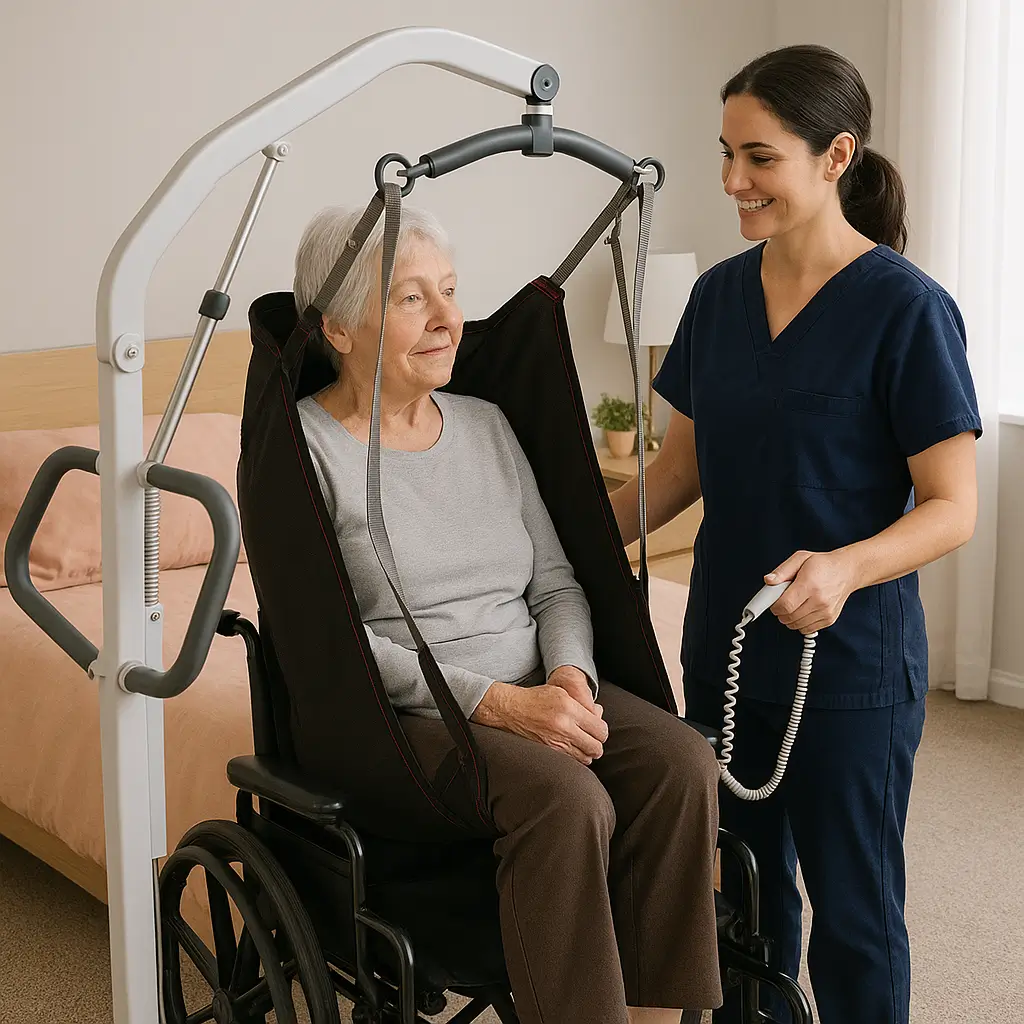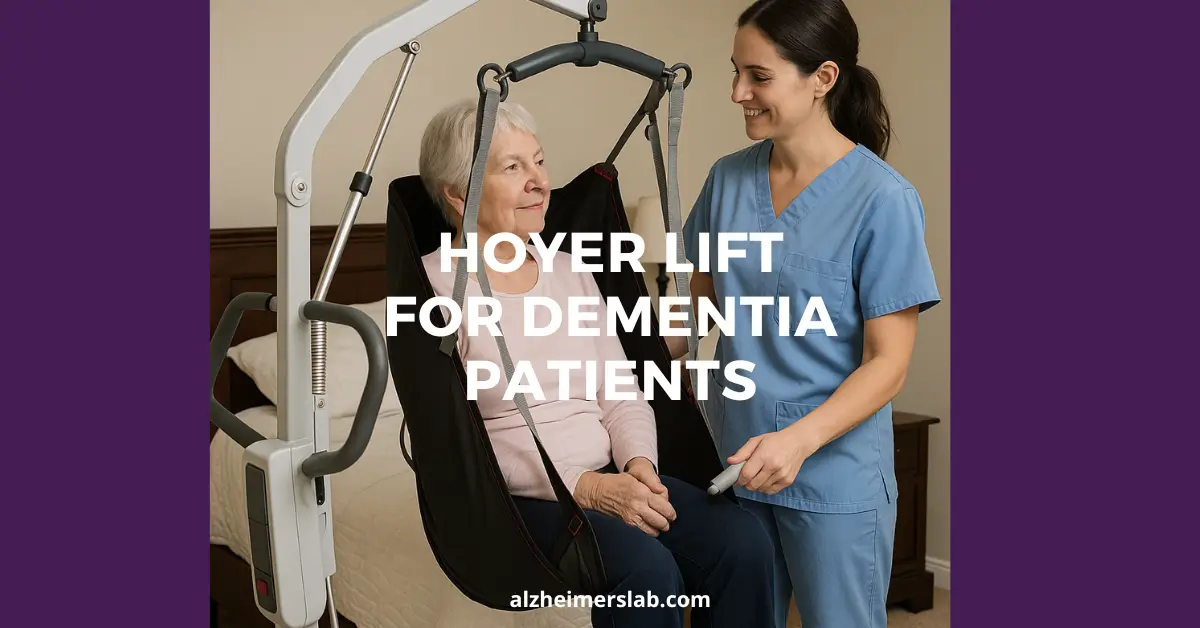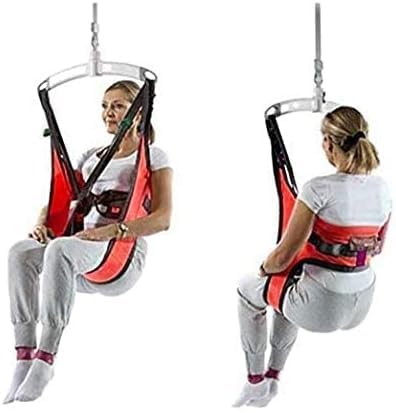Best Hoyer Lifts to Make Dementia Care Easier
As an Amazon Associate, I earn from qualifying purchase.
Are you caring for a loved one with dementia and looking for a way to make transfers easier? It can be tough to lift and move someone safely, especially if they need extra support. In these situations, a Hoyer lift can be a real help. It provides a safe and comfortable way to transfer them from one place to another without straining your back. Let me share some of the best Hoyer lifts for dementia patients with you.
Here Are the Best Hoyer Lift For Dementia Patients
1. Vocic Electric Transfer Lift
The Vocic Electric Transfer Lift is a helpful device for caregivers assisting senior family members, especially those with dementia. It is designed for short-distance transfers, making it easier to move someone from a bed to a wheelchair or sofa.
The lift can extend from 28.4 inches to 68.1 inches, providing flexibility for different situations. However, it’s important to remember that it doesn’t lift from the floor, which could be a limitation in some cases.
Made from strong steel, the Vocic lift is built to last and ensures safety. Its motorized mechanism, adjustable base, and 360° rotating sling arm make positioning simple, reducing strain on caregivers. With a weight capacity of 440 pounds, it can comfortably support various patients, making it a versatile choice for home care or facilities.
In terms of safety, this transfer lift helps prevent injuries by offering a stable transfer experience. The motorized function takes away the need for manual lifting, which is a common cause of injuries for caregivers. While it works well for vertical lifts, the lack of a floor-lifting feature might be something to think about if there is a need for that kind of support.
Pros:
- Durable construction with high-strength steel for safety
- Adjustable base and 360° rotating sling arm for easy positioning
- High weight capacity of up to 440 pounds
Cons:
- Not capable of floor lifting
- May require more space for maneuvering due to its adjustable base
2. Invacare Lightweight Hydraulic Patient Lift
The Invacare Lightweight Hydraulic Patient Lift is very helpful for anyone caring for a family member with limited mobility, especially if they have dementia. This lift makes it easier to move someone from a bed or chair without putting strain on yourself or causing discomfort to the person being lifted.
The hydraulic system allows for smooth movements, which can help reduce anxiety for those being lifted, making the experience calmer and safer for everyone involved.
Setting up the lift is straightforward, as it comes mostly pre-assembled. This means that caregivers can quickly get it ready for use without needing special tools or complicated instructions. The swivel bar is easy to attach, allowing for immediate use. This simplicity helps caregivers integrate the lift into daily routines, allowing more focus on providing care instead of dealing with equipment.
Affordability is another important aspect of this lift. Medical equipment can often be expensive, but this model offers good quality at a reasonable price. This makes it a practical choice for families needing reliable assistance for lifting without overspending.
Overall, the Invacare Lightweight Hydraulic Patient Lift stands out for its effective design and ease of use, helping caregivers manage their responsibilities with less stress.
Pros:
- Easy to assemble and use without tools.
- Provides smooth and controlled lifting, reducing anxiety for patients.
- Affordable option for quality lifting assistance.
Cons:
- May not be suitable for very heavy patients.
- Requires manual effort to operate the hydraulic mechanism.
3. Fushida Lift Sling
The Fushida Lift Sling is one of those products that really takes the stress out of caregiving. It’s made from soft padded mesh, so it feels gentle while still being strong enough to support transfers for bathing, toileting, or just helping someone reposition comfortably.
What I like is how versatile it is. It works with most lift systems and can handle between 200–500 lbs, so it fits a wide range of needs. That gives a lot of peace of mind when you’re helping a loved one move safely.
Cleaning it is simple too. Since it’s washable and reusable, you don’t have to worry about hygiene or buying replacements all the time.
Another nice touch is the wide opening, which makes toileting easier and less of a hassle for both the person using it and the caregiver. The only drawback is that sizing can be tricky. It might not fit perfectly for every body type, especially for smaller folks who need a snugger fit.
Pros
- Soft, padded material keeps it comfortable.
- Washable and reusable, which makes cleaning easy.
- Works with most common lift systems.
Cons
- May not fit every body type well.
- Not ideal for smaller individuals who need a snugger fit.
4. ProBasics Heavy Duty Patient Lift
The ProBasics Heavy Duty Patient Lift is a reliable tool for transferring a senior family member, especially when they weigh up to 450 lbs. This lift has 5-inch front and rear casters, making it easy to move around different areas in the home.
When using the lift, the wheels can be locked with a simple step on the lift plunger. This locking feature is essential for safety, particularly when assisting someone with dementia, as it ensures stability during transfers.
This patient lift is designed to be versatile. It can lift individuals from 26 inches to 70.5 inches, which means it can be adjusted to suit different heights and situations. However, it’s important to remember that a sling is needed for the lift, and this must be bought separately.
The ProBasics lift works with both 4-point and 6-point slings, allowing caregivers to select the best option based on the specific needs of the individual being cared for.
Using the lift is straightforward. Simply secure the patient in the sling, attach it to the lift, and pump the handle to elevate them. This easy operation promotes a safer transfer process. Overall, the ProBasics Heavy Duty Patient Lift is a dependable choice for anyone needing to assist senior family members, particularly those who require careful handling due to health conditions.
Pros:
- Supports patients up to 450 lbs.
- Easy to maneuver with locking casters.
- Simple operation for caregivers.
Cons:
- Sling must be purchased separately.
- Limited to specific lift sling compatibility.
Buyer’s Guide – A Caregiver’s Guide to Choosing the Best Hoyer Lift for Dementia Patients
What is a Hoyer Lift?

A Hoyer lift is a type of mechanical device used to move individuals who have limited mobility. It is especially helpful for caregivers who assist people in transferring from one place to another, such as from a bed to a wheelchair or a chair. The lift uses a hydraulic or electric system to lift and lower the patient safely and comfortably. This device is named after its inventor, Gerhard Hoyer, and has become a vital tool in healthcare and home care settings.
Why Use a Hoyer Lift?
Using a Hoyer lift provides several benefits for both caregivers and patients. First and foremost, it reduces the physical strain on caregivers. Lifting a person manually can lead to back injuries and fatigue, making it difficult to provide proper care. A Hoyer lift allows caregivers to perform transfers safely without risking their health.
Additionally, Hoyer lifts promote safety for the patient. Transferring someone who has limited mobility can be dangerous if not done correctly. A Hoyer lift minimizes the risk of falls and injuries during transfers, ensuring that the patient remains secure throughout the process.
Furthermore, using a Hoyer lift can enhance the patient’s comfort. The lift allows for a gentle and smooth transfer, reducing the anxiety that often comes with being moved. Patients with dementia may feel more at ease when using a device specifically designed for their needs, rather than being lifted manually.
How It Can Help Dementia Patients
Dementia patients often experience difficulties with movement and coordination. They may have trouble understanding instructions or may become confused during transfers. A Hoyer lift can significantly help in these situations by providing a reliable and straightforward method for moving them safely.
One of the key advantages of using a Hoyer lift for dementia patients is the control it offers. Caregivers can easily operate the lift, allowing for a smooth transfer without causing distress. This is particularly important for individuals who may become anxious or agitated during physical movement.
Moreover, Hoyer lifts can help maintain dignity for dementia patients. Many individuals may feel embarrassed about needing assistance. Using a lift allows for discreet transfers, promoting a sense of privacy and comfort. It also allows patients to be involved in the process, as they can see and understand what is happening during the transfer.
Does It Come with a Transfer Sling?
When considering a Hoyer lift, it’s essential to check whether it comes with a transfer sling. Some models include a sling, while others may require a separate purchase (amazon.com link). A transfer sling is crucial as it supports the patient during the transfer, ensuring their safety and comfort.
There are various types of slings available, each designed for different needs. For dementia patients, a padded sling may be the best option, providing additional comfort. It’s essential to select a sling that is compatible with the Hoyer lift being used. If the lift does not come with a sling, it is important to purchase one that fits well and meets the safety standards.
How to Install a Hoyer Lift
Installing a Hoyer lift may seem daunting, but it is generally straightforward. Here are some basic steps to follow:
- Choose a Location: First, select a flat and spacious area for the lift. Make sure there is enough room for the lift to operate without obstacles.
- Assemble the Lift: Most Hoyer lifts come with an instruction manual that outlines the assembly process. Follow the instructions carefully, ensuring all parts are securely connected.
- Attach the Sling: If the lift requires a sling, attach it according to the manufacturer’s instructions. Make sure it is securely fastened and properly adjusted to fit the patient.
- Test the Lift: Before using the lift with a patient, test it with a weighted object to ensure it operates smoothly. Check all functions, including lifting and lowering mechanisms, to confirm they work correctly.
- Read the Manual: Always review the user manual for specific instructions and safety information. This ensures that the lift is used correctly and safely.
Negatives and Safety Considerations
While Hoyer lifts provide many benefits, there are some negatives and safety considerations to keep in mind. First, not all Hoyer lifts are suitable for every patient. It is important to consider the patient’s weight and size to ensure the lift can accommodate them safely.
Additionally, caregivers should always be trained on how to use the lift properly. Improper use can lead to accidents and injuries for both the caregiver and the patient. Always make sure the lift is stable before transferring the patient.
Another consideration is the lift’s maintenance. Regularly inspect the lift for any signs of wear and tear. Check the hydraulic system or battery (for electric lifts) to ensure they function correctly. Any malfunction can pose a safety risk during use.
Finally, ensure that the environment is safe for the use of a Hoyer lift. The area should be clear of clutter, and the floor should be dry and free from hazards. It may also be helpful to have another person present during transfers, especially for patients who may be confused or uncooperative.
Thanks for Reading
Thank you for reading this guide on choosing the best Hoyer lift for dementia patients. It is hoped that this information has been helpful in understanding how a Hoyer lift can improve the care and comfort of individuals with dementia. When selecting a product, take the time to consider the specific needs of the patient and pick a lift that best suits those needs.





